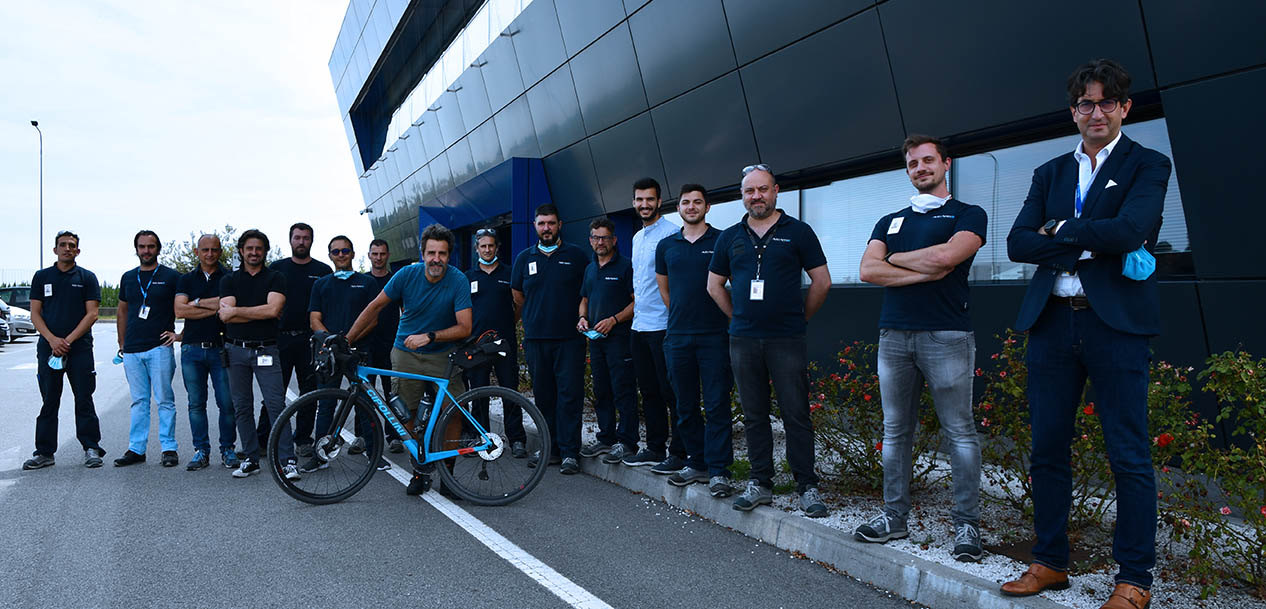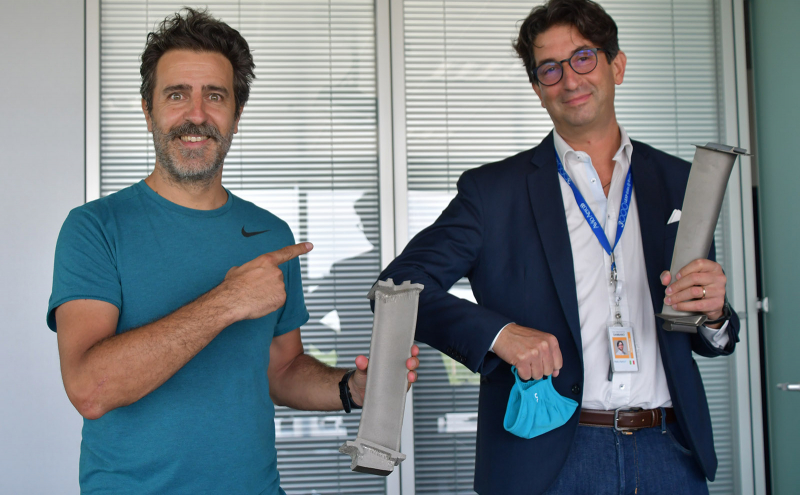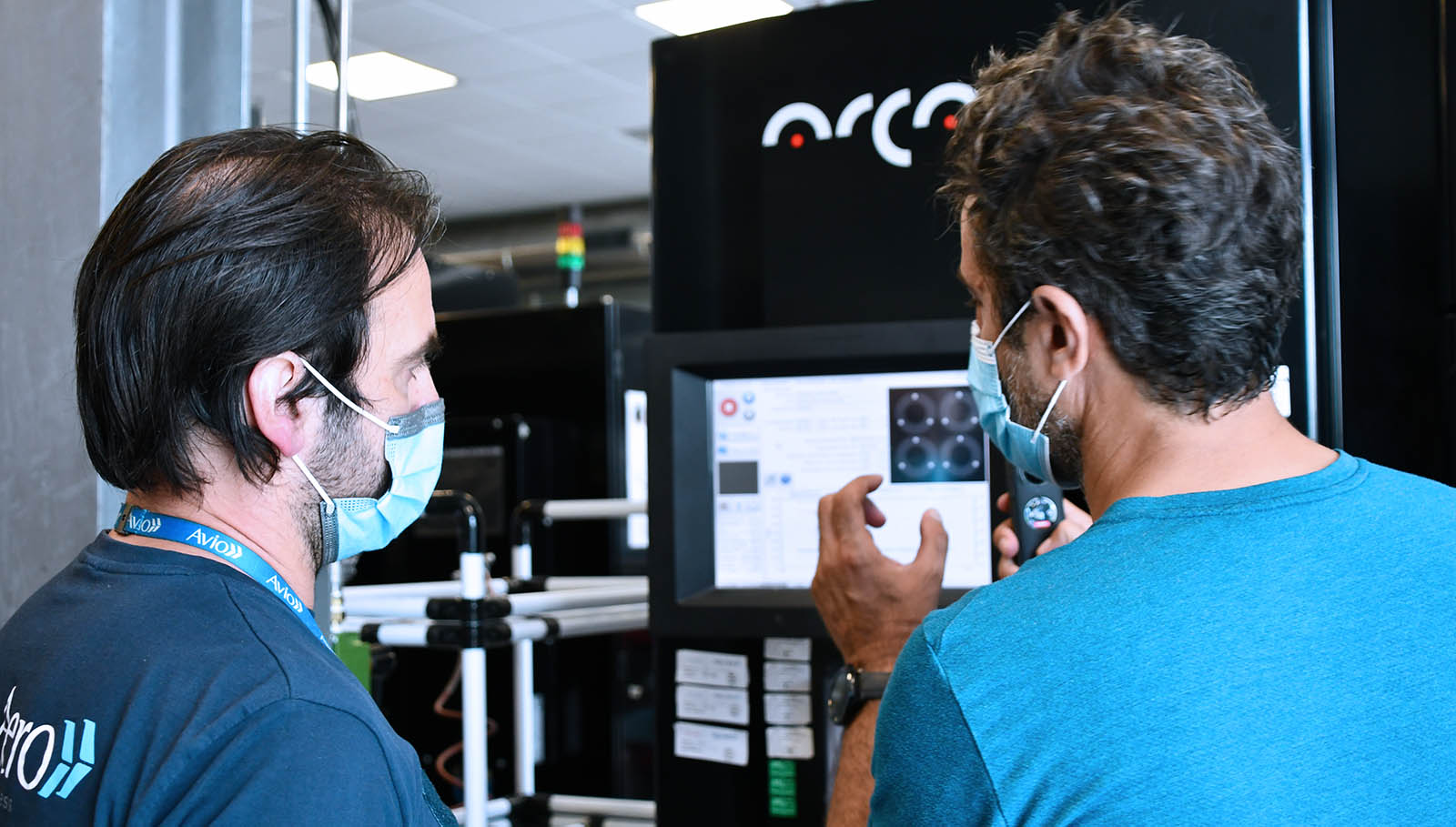Future
The atoms clinic
Massimo Temporelli, the science and technology popularizer with a humanistic vocation, visited Avio Aero Cameri on one of the stops on his special bike tour to present his latest book.
Jul 2021
"We are facing a revolution that in the future might be compared to bronze casting or stone working", said Massimo Temporelli at the end of his guest visit to Avio Aero's Cameri plant in Piedmont.
Engaged in a bike tour from Turin to Trieste, the physicist and science popularizer has stopped by the futuristic factory in Cameri. Escorted in such visit by Vincenzo Trovato, Materials Planning & Execution Manager, and Damiano Mazzotta, Borgaretto & Cameri Plant Leader, Temporelli was able to touch and see what happens inside what he called an "atom clinic", where, thanks to 3D printing, the turbine blades for the world's largest civil engine are produced.
The revolutionary nature of 3D printing, or additive manufacturing (the industrial process used to make objects from digital models by adding layers rather than by subtracting metal powder), lies in the improvement it has brought to the production process, helping to reduce time and waste. In the aerospace sector, one of the greatest impact is on the environment: additive manufacturing allows light alloys (such as Titanium Aluminide, TiAl) to be used, contributing to reducing the total weight of the engine as well as, drastically, to reducing fuel consumption or CO2 emissions.
The impact of 3D printing on the industry is obvious, but the importance of this manufacturing technique is so great that in his book "Noi siamo Tecnologia" [We are technology], Temporelli mentions it as first, among the 10 most important inventions. In fact, an entire chapter is dedicated to 3D printing, considered as one of the top breakthrough inventions of mankind. Temporelli himself explains the reason.
"We may be remembered as the generation that took humanity from traditional manufacturing to machine-based manufacturing, in what will be an incredible industrial revolution that will allow for changes in the geography of manufacturing locations." A new revolution that will also lead to a "new evolution of humanity that will have to relate to new technologies, new scientific products and new production processes".
A long process projected to last for many more years, but thanks to computer science, which has effectively eliminated distances, and to new production technologies, it will lead "to the birth of factories equipped with 3D printers capable of operating in the cloud," explains Temporelli, "moving production sites directly to where they are needed”.
This is a huge step forward that would reduce transport, assembly and maintenance times, while also helping to reduce the environmental impact of the industrial cycle. Not only a technological revolution but also a cultural one, that will force "humanity to invent a new relationship with machines, which are increasingly complex and complicated".
We may be remembered as the generation that took humanity from traditional manufacturing to machine-based manufacturing, in what will be an incredible industrial revolution that will allow for changes in the geography of manufacturing locations
But nothing to fear, Temporelli assures, recalling that “this is not the first time we've encountered machines and the men who have a symbiotic relationship with them. It is a complex relationship, however, because it is not natural and therefore it is stimulating for the human brain." It will take a major cultural and intellectual effort to better understand the machines and technologies of the near future, but in the end "we will find a way and return to our humanity, the truest one".
If we succeed in this, it will also be thanks to the new generations who “relate to technology in a new way; they understand its importance and how to exploit it before others do,” explains Temporelli, emphasizing the central role of young people. "There must be young people in companies because they have fewer constraints on their thinking and they throw themselves into trying to innovate. In this, from what I was able to see in Cameri, Avio Aero is an important example."
Certainly, however, seeing the world “unfiltered” and possessing a sense of initiative are characteristics that must be accompanied by training, which is considered as fundamental as the involvement of young people in the research and development of new technologies. A key element identified by Temporelli in 2014, when he devised The FabLab: a rapid prototyping lab that uses additive manufacturing to invent new devices, technologies and products for companies.
"It was a lucky intuition that continues to provide satisfaction," Temporelli comments, adding that, at the same time, it would be important "to promote the establishment of other Fab Labs throughout Italy to closely support companies that need to innovate." The bike tour from Turin to Trieste will not only serve for meeting the companies and the entrepreneurs who make innovation the industrial engine of Italy. It also reminds us how important it is to leverage ideas from universities, from research centers or from companies themselves and to make them reality.
The ultimate goal is to continue to innovate and evolve, creating new technologies that reduce production and transport times, as well as offering greater sustainability under various aspects (environmental, economic, and social). It is an irreversible process that is impossible to stop, destined to change the "face" of the Earth in the near future.
.



.jpg)



